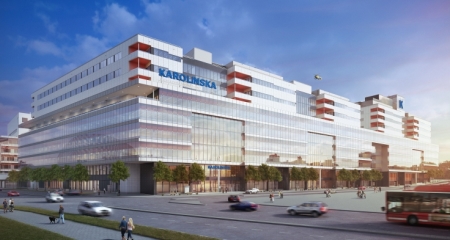The future design of hospitals in the UK and around the world needs to be based on actual patient and staff needs, rather than ‘an obsession with activity’, experts said this week.
Speaking at the second annual European Healthcare Design Conference at the Royal College of Physicians, speakers called for a more patient-centric, holistic approach to service planning and estates improvement.
There is an obsession with trying to minimise activity, but this doesn’t help us to understand or improve the problems we face
Hamish Dibley, an independent management consultant at Dibley Consulting, said: “We have a recorded hospital deficit of £2.5billion.That’s an actual figure, not a forecast, and experts are telling us that patients could suffer as a consequence.
“What we need to understand is why this is happening.”
He said the common scapegoat is that demand is increasing and more people are using services, which just can’t cope. Therefore, more infrastructure is needed.
But, he added: “In UK we have split up who holds the budget – the commissioning bodies - and the people who do stuff – the hospitals. Every year the two sides come together and have a heated debate where they argue for less activity at a lower cost. Then everything goes wrong - and this happens every year. This is absolute madness. We are dehumanising healthcare.
“There is an obsession with trying to minimise activity, but this doesn’t help us to understand or improve the problems we face.
“I call it ‘activity obsession disorder’. It’s what we do in every healthcare economy, every year. It’s organisational Alzheimer’s and we have to change tack.”
Understanding demand
Currently, to address this problem, hospitals and building design teams look at patient flow, activity benchmarking, and carry out service line reviews.
“What we have got to do it bring healthcare back to the reason why we have it – it’s about understanding the needs of patients”, said Dibley.
“What we have at the moment in the NHS is a perverse system that we have to change.
“Rising demand is a myth – it’s not happening. Research has shown the number of people using hospitals in any one year does not really change.”
What does put pressure on health systems, he revealed, was a small percentage of patients who use primary care and hospital services repeatedly.
“Two thirds of people will not use hospitals in any shape or form,” he said.
“What we are seeing is a small percentage of patients coming to hospital 60 or 70 times a year, boomeranging in and out until they die. And it’s not just the elderly. In fact two thirds of these patients are under the age of 65.
Hospitals think they have to make profit, and commissioners are trying to cut costs. We have obliterated why we have a healthcare system in the first place. It must be about care, not profit. We need to have a different conversation
“In one trust the top 20 repeat visitors to A&E were guys in their 30s-50s. We do not help them. Instead, we standardise pathways against mythical patients and that does not work. Patient demand is predictable, stable and repeatable, but some patients are consuming services at alarming levels.
“Providers do not deal with this because they are obsessed with activity.”
He urged trusts to ignore patient flow and activity data and called for changes in the current NHS tariff.
“At the moment hospitals only make money if they do planned care activity. While this is the focus, we will not have the mindset to run effective services,” he said.
“People do not know how to understand the problems and realise that we have people who do not fit into pathways.
“Let’s understand the patient base and the problems for different groups of people and focus on the ‘vital few’ who use the most services.
“Let’s stop looking at pathways, and instead look at cohorts of patients. Why are people coming back for the same things? We should then design prototypes on these small groups of people.
“It’s about changing perspective on what matters.
“Hospitals think they have to make profit, and commissioners are trying to cut costs. We have obliterated why we have a healthcare system in the first place. It must be about care, not profit. We need to have a different conversation.”
Better planning
Once operators have a good grasp of the type of services needed, they can develop the estate to suit, he added.
“Services like chemotherapy and renal dialysis need to take place, but where are they happening? We have got to think about location from a patient’s point of view and we need a thoroughly-different approach to our estate footprint and how we design hospitals.
“It’s about campus-wide masterplans and evidence-informed capital planning.”
In Canada and some parts of Europe that are currently investing large sums in improved healthcare infrastructure, the whole-system approach is helping to cut costs and improve services – a vital combination in the current economic climate.
Speaking at the conference, Denise Blackwell, principal of the Blackwell Management Group in Canada, said the challenging geographical area covered by Alberta Healthcare meant fresh thinking was needed. It has put together a plan to overhaul services, and the healthcare estate, by 2030.
She said: “If we did nothing differently, we predict we would need 2,200 more hospital beds in the next 15 years. That’s six new hospitals and we don’t have the money to do that. We need to do things differently.”
It has to be about changing the entire delivery of healthcare. The buildings are just tools to support that
They have carried out a huge consultation, involving clinical staff, patients and other key stakeholders and have restructured the entire healthcare system, from community and home care through to acute services. They have also looked at the important role technology will play in helping to deliver services and cut costs.
She said: “It’s about right-sizing the system.
“As a result of doing things differently – focusing on health promotion and injury reduction across patient groups - we expect to see a tremendous reduction in demand for healthcare and this will impact on cost.
“With have got to be more pro-active and concentrate on community-based services.
“The thought is that, by 2025, if we can deal with the community pathways and divert attention, we can change what we do in acute care and this should reduce A&E visits and improve the overall use of the estate.”
Sweden is also going down the same road. It has brought together nine key healthcare architects to lead a revolution in the delivery of the health estate.
Pathways of care
Speaking to BBH at the conference, Charlotte Ruben of White Arkitekter explained how a patient-centred approach has been used in the design of the New Karolinska Solna in Stockholm, an inner-city university hospital.
“In Sweden we have so much old building stock that is outdated and we have waited too long to take care of these facilities. It’s a much-better investment now to build new than to keep on renovating.”
But, in a similar approach to that in Canada, the design of the New Karolinska Solna has seen the team take into consideration whole pathways of care.
“The hospital is rather unique,” said Ruben. “We are not only moving care into a new building, but are making the way we work much more patient centred.
“It has to be about changing the entire delivery of healthcare. The buildings are just tools to support that.”
As a result of doing things differently – focusing on health promotion and injury reduction across patient groups - we expect to see a tremendous reduction in demand for healthcare and this will impact on cost
And she called for greater international collaboration, telling delegates: “Across the world we do not do post occupancy evaluation very well. We need to change this so we can see what we are doing well and where the problems are.
“We need to collaboration internationally to raise the level of design. That is where events like this come in.
“It has not only got us talking about hospitals and buildings, but about defining whole pathways of care across the broader healthcare system.
“It’s about looking and needs and then designing buildings around those. It’s something many countries miss out on.”

The New Karolinska Solna has been designed to provide a more patient-centred environment




